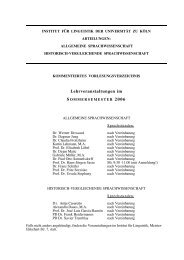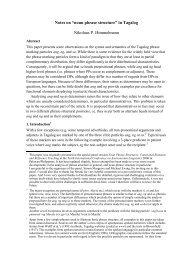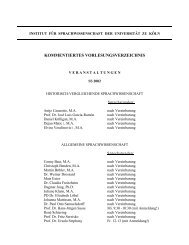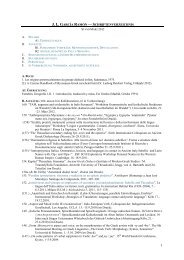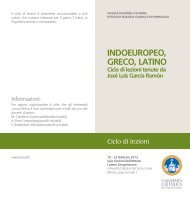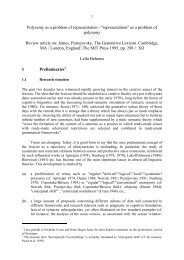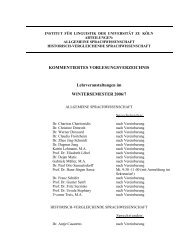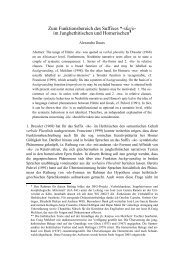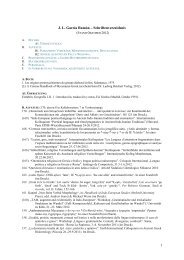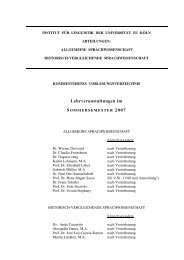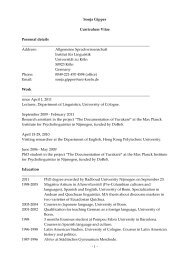Topics in Anatolian Historical Grammar Prof. Dr. H. Craig Melchert
Topics in Anatolian Historical Grammar Prof. Dr. H. Craig Melchert
Topics in Anatolian Historical Grammar Prof. Dr. H. Craig Melchert
You also want an ePaper? Increase the reach of your titles
YUMPU automatically turns print PDFs into web optimized ePapers that Google loves.
Hittite Q-word questions 967<br />
27. In presentational DECLs with the verbs es- ‘‘to be’’ or ki- ‘‘to lie’’ the preferred word<br />
order is LocSV (Luraghi 1990: 105–106).<br />
28. As one anonymous referee suggests, the eagle is apparently thematized via the presence<br />
of a coreferential pronoun, suggest<strong>in</strong>g a topic-comment structure rather than report<strong>in</strong>g<br />
focus, with the eagle as object-topic and the rest of the clause <strong>in</strong> comment focus. An<br />
appropriate translation would thus be ‘‘Who will br<strong>in</strong>g him, the eagle, from the city<br />
of Hassu [to] Pirwa?’’. The only reason for not follow<strong>in</strong>g this otherwise plausible suggestion<br />
is that coreferential NPs occur <strong>in</strong> postverbal, nonpattern position if the referent<br />
of a pronoun is the topic of the INTER (exx. a38b, 68a, 111, KUB 33.87þ i31 0 ,33 0 ).<br />
See a120 for a topic subject pronoun with postverbal coreferential subject NP, and<br />
Section 4.3 for further discussion of postverbal coreferential NPs <strong>in</strong> topic-comment<br />
clauses. It should also be noted that event-report<strong>in</strong>g or thetic DECLs allow topical<br />
nonsubject constituents (Lambrecht 1994: 145; Rosengren 1997: 469–470). I assume<br />
that event-report<strong>in</strong>g INTERs allow them as well.<br />
29. The other report<strong>in</strong>g <strong>in</strong>formation focus examples <strong>in</strong> the corpus are a41 and KUB 8.65 i<br />
27 (both with the subject Q-word <strong>in</strong> <strong>in</strong>itial position).<br />
30. R I ¼ who, R J ¼ -an ‘‘him’’, R K ¼ the eagle, R L ¼ deity Pirwa, R M ¼ city Hassu.<br />
31. One anonymous referee addresses the relationship between the adversative connective<br />
-ma ‘and, but, while’ and the notion of counterexpectation. Although it is true that -ma<br />
occurs <strong>in</strong> contexts <strong>in</strong> which some k<strong>in</strong>d of contrast can be perceived, I do not f<strong>in</strong>d any<br />
connection between -ma and counterexpectant focus. Among the 27 INTERs with<br />
counterexpectant focus <strong>in</strong> the corpus used here, 11 conta<strong>in</strong> -ma (a73, 98b, 99–102,<br />
104, 107, 111c, 113, 115). Of these 11, 7 show an accented pronoun (usually a Subject)<br />
<strong>in</strong> <strong>in</strong>itial position followed by -ma (a73, 99, 100, 104, 107, 113, 115). This strongly suggests<br />
that -ma may be used as a contrastive Topic marker, as was already shown for<br />
Old Hittite DECLs by Rieken (2000). Additional evidence that further weakens a possible<br />
connection between -ma and counterexpectant focus is that -ma may also occur<br />
with an <strong>in</strong>formation focus <strong>in</strong> the clause, as is illustrated by (2) and (4). F<strong>in</strong>ally, of the<br />
66 examples of counterexpectant focus <strong>in</strong> DECLs with 3rd person accented pronouns<br />
<strong>in</strong> Goedegebuure (2003: 283–319), only one example conta<strong>in</strong>ed -ma.<br />
32. Question<strong>in</strong>g focus as a separate category should be deleted from the focus typology <strong>in</strong><br />
Dik (1997a: 330–333) s<strong>in</strong>ce INTERs may also conta<strong>in</strong> the other types of focus mentioned<br />
there.<br />
References<br />
Chafe, Wallace. 1976. Givenness, contrastiveness, def<strong>in</strong>iteness, subjects, topics and po<strong>in</strong>t of<br />
view. In Charles Li (ed.), Subject and topic, 25–56. New York: Academic Press.<br />
Comorovski, Ileana. 1996. Interrogative phrases and the syntax-semantics <strong>in</strong>terface. Dordrecht<br />
& London: Kluwer.<br />
Comrie, Bernard. 1989. Language universals and l<strong>in</strong>guistic typology: syntax and morphology,<br />
2nd revised edn. Oxford & Chicago: Blackwell & University of Chicago Press.<br />
Cornish, Francis. 2004. Focus of attention <strong>in</strong> discourse. In J. Lachlan Mackenzie & María<br />
de los Ángeles Gómez-González (eds.), A new architecture for functional grammar, 117–<br />
150. Berl<strong>in</strong> & New York: Mouton de Gruyter.<br />
Dik, Simon C. 1989. The theory of functional grammar, part 1: The structure of the clause<br />
(Functional <strong>Grammar</strong> Series 9). Dordrecht: Foris.<br />
Dik, Simon C. 1997a. The theory of functional grammar, part I: The structure of the clause,<br />
edited by Kees Hengeveld (Functional <strong>Grammar</strong> Series 20). 2nd rev. edn. Berl<strong>in</strong> & New<br />
York: Mouton de Gruyter.



